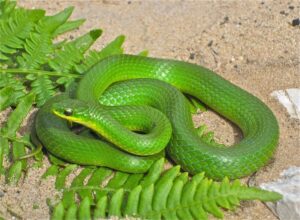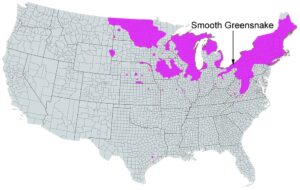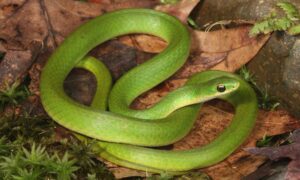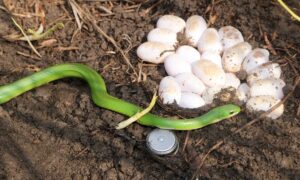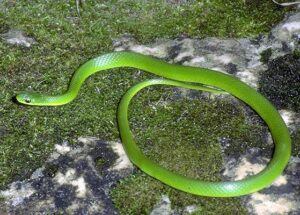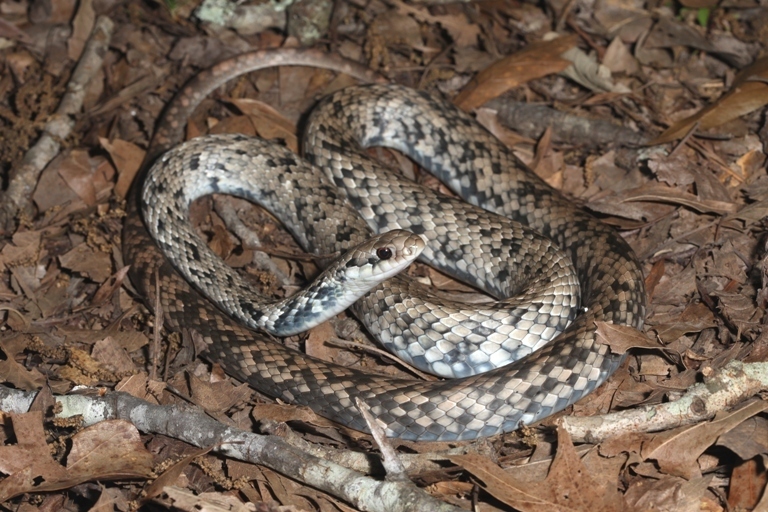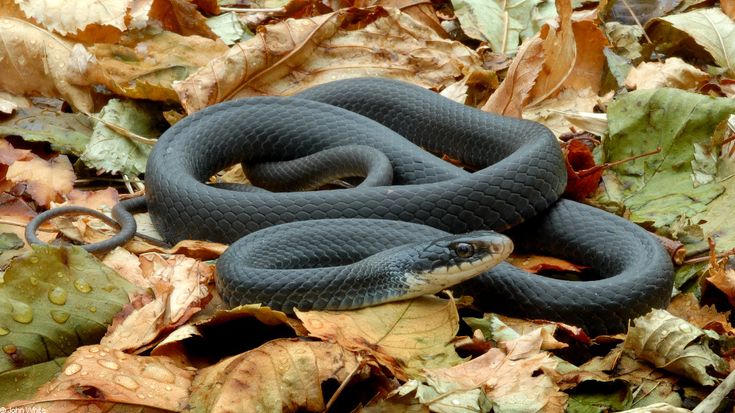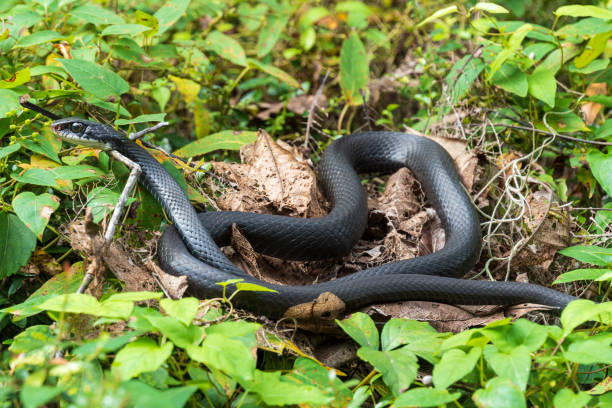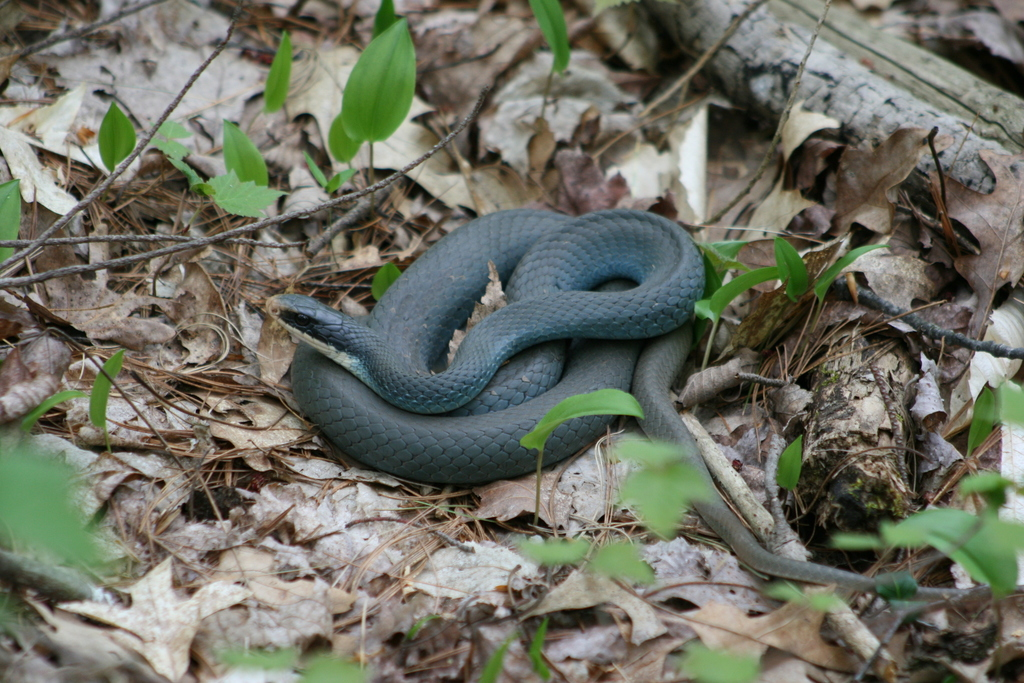The smooth green snake is a slender, small-medium snake endemic to the Nearctic region. Its common name is in recognition of its smooth dorsal scales. The species use their green scales for camouflaging. Additionally, they often bob their heads to mimic vegetation blowing in the wind.
Scientific Classifications
- Suborder:Serpentes
- Family:Colubridae
- Genus:Opheodrys
- Species:O. vernalis
Conservation Status
Subspecies
This snake has three recognized subspecies.
- Eastern smooth green snake (Opheodrys vernalis vernalis)
- Western smooth green snake (Opheodrys vernalis blanchardi)
- Northern smooth green snake (Opheodrys vernalis borealis)
Description
Size
The full-grown snakes attain a total length of 14-20 in (36-51 cm), including their tails. The longest smooth green snake was 26 in (66 cm) in total length. The tails make up a quarter to half the snake’s length. The males have longer tails than the females.
Color and Appearance
Its back is uniform light green with a white or yellow belly. Its smooth dorsal scales are arranged in 15 rows at the midbody. The dorsal coloration can vary with location – olive-tinted light brown in southeastern Texas, bluish in Kansas, and bronze in northern Wisconsin. The red tongue with a black end is flicked in and out of its mouth to smell things around it. It sheds skin every 4-5 weeks, making way for new growth.
The juveniles have olive green, brown, or blue-gray dorsal coloration at first that changes to the characteristic bright green after the first shedding of their skin.
Are They Dangerous to Humans
The non-aggressive snake flees on being threatened and seldom bites. Its bite is non-venomous. When provoked, it can secrete a foul-smelling substance from its anal gland.
As pets, they are very docile and allow humans to come close. When handled, it first becomes excited and then calms down, wrapping itself around a finger.
Smooth Green Snakes at a Glance
Distribution
The range extends through southeastern Canada, west through Saskatchewan, and south through Virginia and Illinois. It also inhabits other areas, like Colorado, Wyoming, New Mexico, Iowa, Texas, Missouri, and Northern Mexico.
Habitat
It lives in open woods, meadows, marshes, and along stream edges.
Smooth green snakes tend to be active both day and night during the warmer months. The colder winter months see them hibernating in social groups in burrows of other animals and ant hills.
Their population is declining due to habitat loss attributed to cattle grazing, mining, road building, logging, and the draining of streams. Indiscriminate use of pesticides is also a major contributing factor as it kills insects, a significant part of its diet. Plus, the snakes are commercially collected for their attractive looks, small size, and passive nature. But they don’t do well in captivity.
Lifespan
Their lifespan in the wild is unknown. They have been known to live for around 6 years in captivity.
Predators
Its predators are the great blue heron, red-tailed hawk, rough-legged buzzard, raccoon, bear, fox, and the common house cat.
Diet
It mainly eats spiders, insects, and other invertebrates, including harvestmen, caterpillars, moths, worms, ants, slugs, and snails.
While hunting, it turns its head from side to side and uses its tongue to find its prey. Its eyesight is pretty strong, at least for shorter distances. As it has no ears, it largely relies on vibrations to figure out its surroundings. It kills with a strike instead of constriction. The stretchy ligaments in its jaw allow it to swallow the prey whole, even if the prey is bigger than the diameter of its body.
Reproduction
Oviparous (lays eggs that hatch outside the body)
The smooth green snake mates from late spring to summer. A gravid female lays eggs from June to September in mounds of decaying vegetation, sawdust piles, rodent burrows, or rotting logs. They have communal nesting in the northern parts of their range. The eggs are usually laid in two clutches of 4-6 eggs each. The thin-shelled, white, and oval eggs are 1-inch in length and 2.6 g in average mass. They hatch after 23 days.
Similar Species
The rough green snake, Opheodrys aestivus, has keeled dorsal scales. They are not smooth like those of the smooth green snake.
Care Sheet
Size of the Enclosure: A 10-gallon aquarium with a secure screened lid comfortably houses a smooth green snake. A 20-gallon tank provides more moving space for your pet and room for decoration.
Temperature: The hot end should be maintained at a temperature of 80-85°F while the cooler side temperature should be in the low 70s.
Humidity: They need roughly 40-50% humidity. A bowl of clean and fresh water should always be kept in the cage.
Substrate: Moisture-retaining substrates like cypress mulch fares well for the snake.
Feeding: The pets can be fed small roaches, crickets, silkworms, beetle larvae, non-hairy caterpillars, katydids, or moths at least thrice a week. They should be offered a few food items per feed.
Source
inaturalist.ca, eol.org, virginiaherpetologicalsociety.com, staticflickr.com, a-z-animals.com, dupageforest.org


